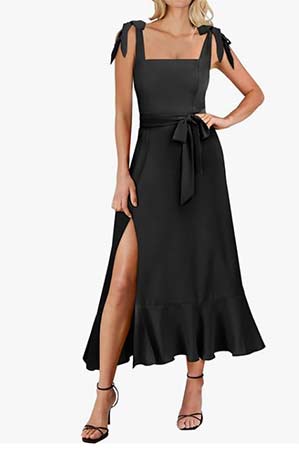The primary factor in determining the style of your bridal bouquets is the style of your wedding gown and your bridesmaids’ gowns. It is important to choose bouquet flowers that complement and balance with the gowns, rather than detract from or overwhelm them. The size of the bouquet is also very important and should not overpower or diminish the bride’s or attendants’ overall appearance.
Wedding bouquet styles range from the casual ‘picked fresh from the garden’ look, to a highly stylized and formal presentation. There are 11 major bouquet styles for the bride to choose from. Here’s a brief description of these styles:
 Arm Bouquet
Arm Bouquet The arm bouquet is an arrangement of long-stemmed flowers meant to be cradled in the arm like one would cradle a baby. This bouquet can be either full and sweeping with many different types of flowers, or simple and classic with only one or two blossom varieties. It is most often seen being presented to beauty pageant winners.
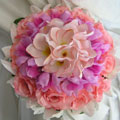 Biedermeier
Biedermeier This European-influenced bouquet is small and compact with flowers organized in alternating rings that resemble a bull’s eye. The alternating rings can either be distinguished by different colors or different types of flowers.
 Cascade
Cascade Also known as a teardrop bouquet, the cascade is a long sweeping flow of flowers waterfalling from the central bouquet. This dramatic look continues to be a favorite of brides and is often composed of many varieties of flowers.
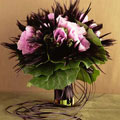 Contemporary
Contemporary Also known as a free-form bouquet, the contemporary bouquet doesn’t follow any traditional rule of flower arrangement and is noted for its unconventional and striking appearance.
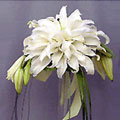 Composite
Composite The composite bouquet is unique in that it is usually a “flower” that does not exist in nature, but rather a fusion of individual petals brought together by wiring or gluing. Not all florists are experienced in creating composite bouquets, so you may have to search around before finding one who can complete this look.
 Nosegay
Nosegay Also known as a posey, this flower arrangement is a small, round, and compact cluster of one or two blossom types. Tightly wrapped and tied with ribbon, the nosegay is smaller than a round bouquet, often used for bridesmaids or flower girls, and frequently has more greenery and ribbons than a traditional round bouquet.
 Pomander
Pomander The pomander bouquet is simply a ball of flowers suspended from a looped ribbon. The pomander is created by inserting the flower stems into a globed base and is held by the ribbon or slipped over the wrist. This is a suitable bouquet for flower girls.
 Round
Round Also known as a Colonial bouquet, the round is a large, formal, and circular bouquet. It does not always have to be perfectly round and can either be designed in a tight bunch or more loosely for a more relaxed look.
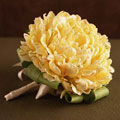 Single Stem
Single Stem Striking in its simplicity, the single stem bouquet is most often created with a large, dramatic flower and is generously wrapped with ribbons. Peonies, hydrangeas, calla lilies, and birds of paradise are ideal flowers for this type of arrangement.
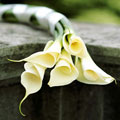 Hand-Tied
Hand-Tied is also known as the tussy-mussy bouquet, the hand-tied bouquet is extremely popular with modern brides and has a natural feel best suited for the understated wedding. If not tightly tied with ribbons, this bouquet can be placed in a Victorian tussy mussy – an ornamental, cone-shaped holder.
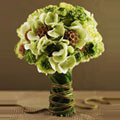 Throw Bouquet
Throw Bouquet This is the perfect option for those brides who do not want to toss their wedding bouquet. Have your florist create a smaller and less ornate version of your wedding bouquet, perfect for the bouquet-tossing ceremony at your reception.
WEDDING FLORAL ARRANGEMENTS

 Arm Bouquet The arm bouquet is an arrangement of long-stemmed flowers meant to be cradled in the arm like one would cradle a baby. This bouquet can be either full and sweeping with many different types of flowers, or simple and classic with only one or two blossom varieties. It is most often seen being presented to beauty pageant winners.
Arm Bouquet The arm bouquet is an arrangement of long-stemmed flowers meant to be cradled in the arm like one would cradle a baby. This bouquet can be either full and sweeping with many different types of flowers, or simple and classic with only one or two blossom varieties. It is most often seen being presented to beauty pageant winners. Biedermeier This European-influenced bouquet is small and compact with flowers organized in alternating rings that resemble a bull’s eye. The alternating rings can either be distinguished by different colors or different types of flowers.
Biedermeier This European-influenced bouquet is small and compact with flowers organized in alternating rings that resemble a bull’s eye. The alternating rings can either be distinguished by different colors or different types of flowers. Cascade Also known as a teardrop bouquet, the cascade is a long sweeping flow of flowers waterfalling from the central bouquet. This dramatic look continues to be a favorite of brides and is often composed of many varieties of flowers.
Cascade Also known as a teardrop bouquet, the cascade is a long sweeping flow of flowers waterfalling from the central bouquet. This dramatic look continues to be a favorite of brides and is often composed of many varieties of flowers. Contemporary Also known as a free-form bouquet, the contemporary bouquet doesn’t follow any traditional rule of flower arrangement and is noted for its unconventional and striking appearance.
Contemporary Also known as a free-form bouquet, the contemporary bouquet doesn’t follow any traditional rule of flower arrangement and is noted for its unconventional and striking appearance. Composite The composite bouquet is unique in that it is usually a “flower” that does not exist in nature, but rather a fusion of individual petals brought together by wiring or gluing. Not all florists are experienced in creating composite bouquets, so you may have to search around before finding one who can complete this look.
Composite The composite bouquet is unique in that it is usually a “flower” that does not exist in nature, but rather a fusion of individual petals brought together by wiring or gluing. Not all florists are experienced in creating composite bouquets, so you may have to search around before finding one who can complete this look. Nosegay Also known as a posey, this flower arrangement is a small, round, and compact cluster of one or two blossom types. Tightly wrapped and tied with ribbon, the nosegay is smaller than a round bouquet, often used for bridesmaids or flower girls, and frequently has more greenery and ribbons than a traditional round bouquet.
Nosegay Also known as a posey, this flower arrangement is a small, round, and compact cluster of one or two blossom types. Tightly wrapped and tied with ribbon, the nosegay is smaller than a round bouquet, often used for bridesmaids or flower girls, and frequently has more greenery and ribbons than a traditional round bouquet. Pomander The pomander bouquet is simply a ball of flowers suspended from a looped ribbon. The pomander is created by inserting the flower stems into a globed base and is held by the ribbon or slipped over the wrist. This is a suitable bouquet for flower girls.
Pomander The pomander bouquet is simply a ball of flowers suspended from a looped ribbon. The pomander is created by inserting the flower stems into a globed base and is held by the ribbon or slipped over the wrist. This is a suitable bouquet for flower girls. Round Also known as a Colonial bouquet, the round is a large, formal, and circular bouquet. It does not always have to be perfectly round and can either be designed in a tight bunch or more loosely for a more relaxed look.
Round Also known as a Colonial bouquet, the round is a large, formal, and circular bouquet. It does not always have to be perfectly round and can either be designed in a tight bunch or more loosely for a more relaxed look. Single Stem Striking in its simplicity, the single stem bouquet is most often created with a large, dramatic flower and is generously wrapped with ribbons. Peonies, hydrangeas, calla lilies, and birds of paradise are ideal flowers for this type of arrangement.
Single Stem Striking in its simplicity, the single stem bouquet is most often created with a large, dramatic flower and is generously wrapped with ribbons. Peonies, hydrangeas, calla lilies, and birds of paradise are ideal flowers for this type of arrangement. Hand-Tied is also known as the tussy-mussy bouquet, the hand-tied bouquet is extremely popular with modern brides and has a natural feel best suited for the understated wedding. If not tightly tied with ribbons, this bouquet can be placed in a Victorian tussy mussy – an ornamental, cone-shaped holder.
Hand-Tied is also known as the tussy-mussy bouquet, the hand-tied bouquet is extremely popular with modern brides and has a natural feel best suited for the understated wedding. If not tightly tied with ribbons, this bouquet can be placed in a Victorian tussy mussy – an ornamental, cone-shaped holder. Throw Bouquet This is the perfect option for those brides who do not want to toss their wedding bouquet. Have your florist create a smaller and less ornate version of your wedding bouquet, perfect for the bouquet-tossing ceremony at your reception.
Throw Bouquet This is the perfect option for those brides who do not want to toss their wedding bouquet. Have your florist create a smaller and less ornate version of your wedding bouquet, perfect for the bouquet-tossing ceremony at your reception.